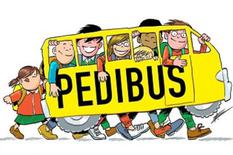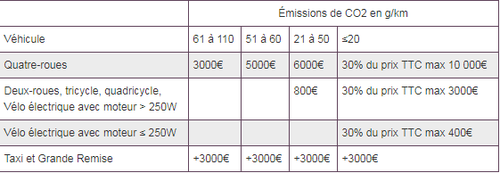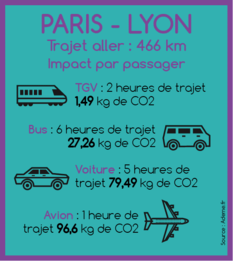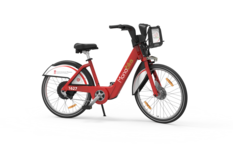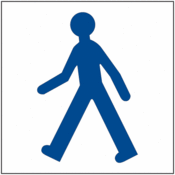Eco-friendly actions : Transport
#1 Organise a walking bus to take your kids to school
What is a walking bus ?
A walking bus is an alternative form of school transport, in which volunteer parents escort children between home and school on foot.
What are the advantages ?
The walking bus concept offers several advantages :
- reducing motorised transport and the associated pollutant emissions as well as the danger that they pose in the areas surrounding schools
- engaging in daily physical exercise which is beneficial for a healthy lifestyle
- creating time for children and adults from the same neighbourhood or school to socialise
- promoting education and independence for young people on road safety and sharing the roadway
How to set it up
1- Identify and bring together interested parents (you will need to pick a coordinator and at least two accompanying parents for every 8–10 children).
2- Determine who all the stakeholders are (parents, children, the school, teachers, City Hall, the urban transport authority – you will need to contact all of them).
3- Establish a legal framework (you will need to check that each of the accompanying parents has civil liability insurance and that this insurance covers them as a walking bus parent, and that the child’s school insurance covers their journey between home and school. In addition, be sure to draw up charters to give your walking bus a clear framework).
4- Organise the walking bus (try to find the shortest, safest, most functional route that allows you to pick up as many children as possible, create a timetable with departure and arrival times, procure hi-vis jackets for the accompanying parents and armbands for the children, etc.).
5- Officially launch your walking bus (try to make it a festive occasion if you can – perhaps provide a snack for the children and their parents on the first trip. Some cities have organised for children to be accompanied by clowns for their first trip!).
6- Conduct a review after a few weeks (and make any improvements that you can).
Resources
- https://www.youtube.com/watch?time_continue=56&v=1-J6OzNGTbA - A video explaining how walking buses work, made by the Swiss Association Transports et Environnement (ATE, Transport and Environment Association)
- http://www.tousapied.org/pedibus-pratique/#france - List of national contacts (France)
- https://www.ademe.fr/sites/default/files/assets/documents/carapatte-caracycle.pdf - The French Agency for Ecological Transition (ADEME) has all the documentation and tools you need to set up a walking bus, a methodology for teachers, legal issues, etc.
#2 Use the Mobee car-sharing scheme
What is Mobee ?
Mobee is the car-sharing service in the Principality of Monaco. It offers 25 vehicles available 24/7 and located throughout the country. You can park the cars for free on the street and in 14 partner car parks !
How do you use Mobee ?
Three subscription options are available :
- Prepaid reloadable card: This new product launched in December 2016 allows you to use the Mobee service without making a commitment – just pay a €10 registration fee and then €30 for every hour of use. The card is valid for 12 months from the date you validate your account.
- Individual annual subscription: There are seven different options, so there’s something for everyone.
- Business annual subscription: There are four different options depending on how frequently you use the service.
You can see the full price list here: https://www.mobee.mc/en/prices
What are the benefits of car sharing ?
Car sharing offers many benefits, with an impact on the health of the environment and your finances :
- No more maintenance, insurance, parking or fuel costs - A clean, reliable car always available somewhere near your home or workplace, 24 hours a day, seven days a week
- Only pay for what you use and you’ll soon be saving several hundred euro a year
- Plus, a vehicle used in a car-sharing scheme saves seven individual cars! So car sharing reduces the amount of space taken up by cars, which is then redistributed (for use by bikes, pedestrians, green spaces, etc.)
Resources
- https://www.mobee.mc/en/faq
- Frequently asked questions about the Mobee service
- https://www.mobee.mc/en/partner-parkings
- List of partner car parks
- https://www.mobee.mc/en/distribution-points
- Map of distribution points
#3 Buy a hybrid or electric vehicle
What are the advantages of an eco-friendly car ?
- It’s less polluting
- It reduces dependence on fossil fuels
- It’s quieter
- It’s less expensive to run
- It requires less maintenance
- You can take advantage of special privileges (e.g. parking spaces)
- No CO2 emissions
What types of vehicle can you get a subsidy for ?
- Electric or hybrid (electric/petrol) motor vehicles with at least four wheels and CO2 emissions of less than or equal to 110g/km
- Electric or hybrid (electric/petrol) two-wheel or three-wheel vehicles and quadricycles with CO2 emissions of less than or equal to 45g/km
- Electric bicycles which do not have a lead battery
How it all works
State support for owners of eco-friendly vehicles is not limited to a subsidy at the time of purchase, but also extends to daily use of the vehicle. This support is available to both individuals and companies. It may be awarded for the purchase of a clean or low-polluting vehicle which:
- Is new or was previously registered as a demonstration vehicle for less than a year by a dealer. Proof must be provided (copy of original registration certificate)
- Is registered in Monaco (with the exception of bikes with a maximum power of 250 W)
- Belongs to a Monegasque resident or a company domiciled in Monaco
How much can I claim ?
Where can I charge my car ?
- Basic charging :
In public car parks (>700)
54 Rue Grimaldi (1)
8 Rue Louis Notari (2)
Rapid and fast charging :
Place des Moulins
54 Rue Grimaldi (1)
8 Rue Louis Notari (3)
24 Avenue de Fontvieille (1)
27 Avenue de la Costa (for taxis and chauffeur-driven vehicles only)
Monte-Carlo Beach car park (Tesla charger)
- Charging points for motorcycles and quadricycles :
54 Rue Grimaldi
8 Rue Louis Notari
Resources
- https://www.gouv.mc/Action-Gouvernementale/L-Environnement/Actualites/Les-velos-a-assistance-electrique-integrent-le-dispositif-d-aide-a-l-achat-des-vehicules-ecologiques - Article about electric bikes (French only)
- https://www.gouv.mc/content/download/465278/5303413/file/Projet%20guide%20VE%20version%20Finale%207%20mars%2019Couv%201%20V2.pdf - Guide to eco-friendly vehicles in the Principality (French only)
#4 Choose the train rather than the plane
What is the difference in environmental impact?
As a result of the oil they consume, aircraft emit huge quantities of greenhouse gases, as well as pollutant gases which are harmful to health, such as nitrogen oxide, sulphur dioxide and carbon monoxide. More specifically, CO2 emissions are estimated at 118 grams per kilometre for long-haul flights, and 145 grams per kilometre for domestic flights. Take-off and landing are responsible for the highest pollutant and CO2 emissions. To prevent disaster, therefore, it’s a good idea to choose the train rather than the plane, especially when travelling for short or medium distances. The train is the least polluting, most efficient form of transport in France, performing even better than cars. It’s worth noting that over an equivalent distance, planes emit an average of 300 times more CO2 than the train. In a world that is preoccupied by the concentration of greenhouse gases in the atmosphere, the train is therefore the perfect mode of transport. A journey from Nantes to Lyon by plane, for example, emits 102 kilograms of CO2 per passenger, while the same journey by train produces just 3.2 kilograms.
How can you offset your carbon footprint from travelling?
Offsetting means using a variety of methods to compensate for the greenhouse gases you’ve emitted into the atmosphere. The quantity of greenhouse gases to offset is calculated in metric tonnes of CO2 equivalent:
- Choose the train rather than the plane
- Stop travelling long distances for short periods of time
- Fund a project which helps to reduce greenhouse gas emissions: one way to compensate for your emissions is to give some money to an organisation, based on the amount of CO2 emitted, that the organisation then uses to offset the emissions.
Resources
- https://www.myclimate.org - Calculate and offset your carbon footprint
- https://www.reforestaction.com/en/carbon-calculator - Calculate and offset your carbon footprint
- https://footprint.wwf.org.uk/#/ - Environmental footprint calculator
#5 Support the launch of teleworking in your company
What is teleworking ?
Teleworking means carrying out an occupational activity remotely (outside your workplace) for some or all of the time, taking advantage of information and communications technologies. Teleworking can be done from home, a telecentre, a branch office or as a nomad (where you work from somewhere different depending on what you are doing) as part of salaried employment, as well as from co-working spaces in the case of independent teleworking. A study carried out in the United States estimated that if employees who were able to do so (accounting for around 40% of jobs) teleworked for one day per week, the country would save around 20 billion litres of oil per year, the equivalent of 45 million fewer tonnes of CO2 released into the atmosphere. That would represent nearly 1% of the country’s emissions.
What are the advantages of teleworking for the environment ?
For the employer :
- Reduced absenteeism and lateness (particularly when there are traffic jams or strikes)
- An opportunity to contribute to reducing the organisation’s carbon footprint
- Reduced infrastructure costs (if an employee is at their home rather than the office, they do not consume any electricity or heating, meaning more savings for the company)
- Improved corporate image (introduction of an eco-friendly practice)
For the teleworker :
- Reduced travel time
- Reduction in transport costs (season tickets, fuel, etc.)
For regions :
- A tool to help limit travel by part of the population to urban areas
Resources
- https://www.dailymotion.com/video/x6voue0 - Video by the French Ministry of Employment explaining the principles of teleworking (French only)
- https://service-public-entreprises.gouv.mc/content/download/317016/3595104/file/Depliant_Teletravail_Print%20BAT%20VALIDE%20Loi%201429.pdf - Official leaflet about teleworking in Monaco (French only)
#6 Use the MonaBike network to get around the Principality
What is MonaBike ?
MonaBike is a fleet of electric bikes available throughout the Principality. Each bike has a range of 60 kilometres and can be charged quickly using a smart terminal.
What subscriptions are available ?
There are a number of price options:
- Single journey = €1
- 24-hr pass = €2
- 7-day pass = €6
- Monthly pass (bike only) = €6/month for a minimum of 12 months
- Monthly pass (combined with bus or public car park season ticket) = €4/month for a minimum of 12 months
In all cases, in addition to the proposed price :
- the first 30 minutes of use are free
- after the first 30 minutes and up to 1 hour costs €1
- after 1 hour, the additional cost is €2 per half-hour
(To use MonaBike, you must be aged 16 or over and more than 1.25 metres tall).
Why should you use an electric bike in the city ?
- To stay healthy : cycling provides a form of daily exercise
- To improve the environment : use an electric bike and reduce greenhouse gas emissions!
- To save fuel : electric bikes use a lot less fuel than a car
- To save time : cycling around town is often quicker than taking the car or the bus
Resources
- https://monabike.mc/ - Official MonaBike website
- https://www.gouv.mc/Action-Gouvernementale/L-Environnement/Actualites/Les-velos-a-assistance-electrique-integrent-le-dispositif-d-aide-a-l-achat-des-vehicules-ecologiques - Subsidies for electric bikes in the Principality (French only)
- https://www.youtube.com/watch?v=Vtcrg1_zBNI - A report on the installation of the first MonaBike terminals (French only)
#7 Use the bus to get around the city
What advantages does the bus offer?
- The least polluting option after cycling
- Inexpensive
- Quicker during rush hour thanks to dedicated bus lanes
- More relaxing than driving
- Convivial
- Season tickets can be combined for use with public car parks and/or MonaBike and/or the regional TER train network (SNCF)
What’s CAM ?
The Monegasque Bus Company, also known as CAM, is a public transport network serving the city of Monaco. The company operates six regular bus services, a night service, the Bateau-Bus water bus service and a number of school services.
How does CAM operate ?
There are six bus services (which run seven days a week) + two Noctambus night services + the Bateau-Bus. The Principality has 142 stops and new smart bus shelters are currently being installed. Users can also take advantage of free connections within 30 minutes of purchasing a ticket. There are many different fare options, which you can see on the CAM website.
CAM and the environment
On 1 January 2008, the Prince’s Government introduced free transport on the Principality’s city bus network for Monegasque nationals and residents aged over 60. The Government also seeks to promote public transport by making buses completely free during events in the Principality, encouraging city residents to leave their cars in the garage.
CAM has a fleet of 16 hybrid buses, the first of which were delivered in June 2011. This technology should reduce fuel consumption by 20–25%. In addition, the advantage of combining this technology and biofuel is that it contributes both to reducing consumption (the hybrid element) and CO2 emissions (the use of the biofuel Diester). Plant-based fuels emit CO2 during combustion, but the plant from which the fuel is produced has first absorbed some carbon dioxide from the atmosphere. The benefit offered by the 30% Diester mix is 23% (7% is lost due to harvesting and industrial processing). In total, the combination of the two leads produces a 40% decline in fossil fuel emissions compared to a conventional bus running on pure diesel fuel.
The Principality’s public buses run on Diester 30%, i.e. 30% biofuel and 70% petroleum diesel.
France’s first ‘biodiesel’, Diester is a biofuel for diesel engines that is produced primarily by processing rapeseed and sunflower oils grown in France. Diester gives back more energy that it takes to produce it. According to the French Agency for Ecological Transition (ADEME), Diester gives back nearly 2.2 times as much energy compared with the (fossil fuel) energy used to manufacture it. ADEME also states that using one tonne of Diester reduces carbon dioxide emissions by 2.6 tonnes. It also reduces atmospheric emissions: smoke fumes, particulates, carbon monoxide, aromatic compounds and unburned hydrocarbons. The introduction of sustainability criteria for biofuels within the European Union should also mean that biofuels from deforested areas are not imported into Europe. Arrow markings on the bodywork are used to highlight the buses which run on hybrid technology. Every time it decelerates, the bus recovers energy.
Resources
- http://www.cam.mc/tarifs.php - CAM fares
- http://www.cam.mc/services.php?idservice=23 - TER + Bus season ticket
- http://www.cam.mc/services.php?idservice=12 - MonaBike + Bus season ticket
- https://webapp.cam.mc/app/fr/ - Live timetable
- http://www.cam.mc/services.php?idservice=11 - Car park + Bus season ticket
- http://www.cam.mc/services.php?idservice=29 - La Carte Azur, a single season ticket for public transport users in the Alpes-Maritimes and Principality of Monaco regions
- http://www.cam.mc/services.php?idservice=14&idarticle=32 - Bateau-Bus
#8 Get around on foot
What are the benefits of walking ?
- No pollution/CO2 emissions
- Free
- Saves time during rush hour
- Opportunity for physical exercise
- Good for mental health
A recently published study confirms that to stay healthy, you should walk between a thousand and ten thousand steps every day!
How do you get around Monaco easily on foot ?
Thanks to its public lifts and escalators, you can get around the Principality effortlessly on foot, in under an hour. The Principality has 79 lifts, 35 escalators and 8 moving walkways.
In addition, the brochure Monaco Malin presents all of the facilities that the Principality offers to help you get around on foot. The leaflet shows the lifts, escalators and pedestrian walkways – both moving and non-moving – as well as the electric bike stations and public transport services available in the Principality by district. Tourist attractions, hospitals and other health facilities are also included to help you find your way around.
Resources
- Download Monaco Malin
- Quebec website providing information about the benefits of walking every day
#9 Arrange to carpool with others
What is carpooling ?
By this, we mean the shared, organised (unlike hitchhiking) use of a car by a non-professional driver and one or more third-party passengers to complete a journey together.
What are the different types of carpooling ?
There are several different versions :
- For home-to-work journeys : this type of carpooling is often used by people who work for the same company, go to the same university or live in the same neighbourhood. It accounts for two thirds of carpooling journeys, and is particularly popular in large companies with more than 300 staff and in government organisations.
- Home-to-school/work : this is where one driver takes children from several families to school. It could be a different driver in the mornings and afternoons and every day of the week. Having arrived at school, the driver may carpool to their workplace with other parents. Sometimes the school car park can be used as somewhere to leave the car for the day.
- Home-car park-work : everyone involved drives their own car to a meeting point – a car park – then they carpool on to their workplace. Car parks at motorway entrances and exits are heavily used, but they sometimes have very limited parking capacity. This type of carpooling is being promoted through the development of park-and-ride car parks.
- Carpooling for recreational purposes : participants attending an event (a music festival, sports event, wedding, the meeting of an association or institution, etc.) can arrange to carpool to the event location. This type of occasional carpooling is defined by the fact that all participants are going to the same place on the same date.
What are the advantages of carpooling ?
Carpooling offers advantages to the individuals involved (sharing fuel and repair costs, making journeys more enjoyable, developing social relationships) as well as benefits for the wider community (increased vehicle occupancy rates, reduced traffic jams and pollution). Moreover, carpooling can reduce pollutant and greenhouse gas emissions by 30%.
How can you get involved in carpooling ?
- Make arrangements with your colleagues, friends, family or others
- Use an official carpooling platform such as Blablacar
- Organise a carpooling scheme via your child’s school or your company
Resources
- Blablacar website (paid service)
- Carpooling platform comparison website
- Carpooling website (paid service)
- Service offering car rental for €1 (useful for organising carpooling if you don’t have a car)
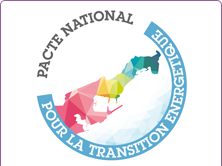

[#YourMonaco]
— Gouvernement Monaco (@GvtMonaco) July 31, 2020
La Principauté se dote d'un nouvel outil de communication urbaine. https://t.co/5f1DsYi2No


